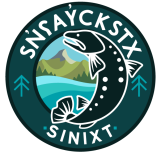Photo credit: Mike Graeme
Land Acknowledgement
What is a territorial land acknowledgment?
What should be included in this acknowledgment?
A traditional land acknowledgment that reflects the immediate and local area precisely carries the most weight of respect. Where do you live? What do you know about the immediate area’s Indigenous/Aboriginal history? Where was the nearest Sinixt village, as documented in the historical record? For example, pithouse depressions in the Rosemont area of Nelson indicate year-round settlement of Sinixt people there. Caribou Creek near Burton, (in the Arrow Lakes Valley) was, on early maps you can find on this website, the “Sin-Atch-Eggs (Sinixt) River”.
This website, and several books about the Sinixt detailed here contain a wealth of information about Sinixt presence across the region.
Is it best to have the Sinixt help communities create their acknowledgment?
No. The best land acknowledgments come from settlers who research and learn before they speak. We encourage all communities or individuals to do so before developing their acknowledgment.
Sinixt territorial boundaries are defined clearly on this website, and can be found by studying the map here. These boundaries are reflected in maps prepared by expert anthropologists and the province itself in 1956, the year we were declared extinct.
Here is a sample, general acknowledgement for any contemporary community within the transboundary, traditional territory of the Sinixt.
I/We would like to acknowledge that we are gathered here today on the traditional, ancestral and unceded territory of the Sinixt people.

